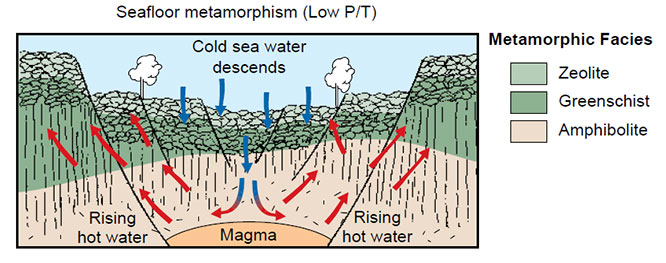Seafloor Basalt
Interaction between cold seawater and hot mafic-ultramafic rocks in the 65.000 km long oceanic spreading-ridge system is likely the largest active metamorphic system on the planet. Because of seafloor spreading, the metasomatic products cover a major part of the planet and, therefore, in term of area, are the most extensive of any metamorphic terrane. The most accessible products of ocean-ridge metamorphism are exposed as ophiolite on land along margins of overriding plates in subduction zones. Although the nature of Ophiolites provides important insight into the geology of the oceanic lithosphere, particularly of the deeper crust and mantle interface inaccessible by drilling on the ocean-floor.Variable degrees of recrystallization and metasomatims at spreading ridges convert oceanic basalt rocks (MORB) into low-grade greenstone, spilites, and less common amphibolites. Ocean ridge metamorphism converts olivine and pyroxene into hydrated silicates, including serpentine, chlorite, and talc. This is the most characteristic kind of metamorphism in the oceanic crust. As much as one-fourth of the oceanic crust is metamorphosed in this way.
Cann (1979) recognises 4 different mineral assemblage facies in oceanic basalts recovered by dredging, drilling etc. The rocks characteristically preserve igneous textures.
(1) Brownstone Facies:
Low temperature ocean floor weathering or cool hydrothermal alteration. Products usually have yellowish brown tint due to oxidizing conditions (bluish grey if reducing). Mineral assemblages are not in equilibrium. Olivine is replaced by Celadonite (K-rich dioctahedral Fe-illite) under more extreme alteration. This fills vesicles and replaces glass. Under reducing conditions Olivine is replaced by Saponite (Mg-rich trioctahedral smectite). Pyrite is common. Thus basalt has clay alteration products. Plagioclase remains fresh, though under extreme alteration may be partly replaced by K-feldspar (Adularia).
Glass: Where basalt glass is common, Palagonite (orange coloured disordered illite) occurs, often associated with a low temperature zeolite (Phillipsite) and Calcite.
(2) Zeolite facies ( Temperature above 50-100°C.):
Here Phillipsite is replaced by higher temperature zeolites - Analcite and Natrolite. Mafic minerals are replaced by Saponite or Saponite-Chlorite mixed layer minerals, coarser grained than in Brownstone Facies. Plagioclase may also be partly replaced by saponite, but augite stays fresh. Upper limit of facies (250-300°C) marked by disappearance of zeolites and saponite and incoming of albite and chlorite.
(3) Greenschist Facies:
Albite ± chlorite ± actinolite ± epidote ± sphene. Degree of alteration variable, primary assemblages may be completely replaced. Augite is commonly a relic, veins are common, often quartz-bearing. Assemblages may or may not be equilibrium ones. Upper limit of facies marked by disappearance of albite, chlorite and actinolite and the appearance of green aluminous hornblende associated with more calcic plagioclase (An20-30).
(4) Amphibolite Facies:
Hornblende + Ca-plagioclase + titanomagnetite ± epidote. This assemblage is most commonly developed in coarser grained rocks - dykes and gabbros - of deeper origin. Degree of metamorphism variable. Some primary hornblende occurs in gabbros or diorites, but it is clear that amphibolite facies metamorphic assemblages are superimposed on this. So metamorphism closely follows magmatic activity.
Greenschist and amphibolite facies metamorphism of the ocean floor differs from these facies in normal regional metamorphism in that:
(a) The thermal gradient is very high: can be several-100°C per km compared with 30 - 50°C/km in regional metamorphism.
(b) No garnet is developed in mafic rocks (pressures are not high enough).
(c) The rocks lack deformation textures (except in samples recovered from transform fracture zones)
(d) Very variable degree of recrystallization, because lower grade metamorphic assemblages are superimposed on earlier higher grade ones. This is because hydrothermal activity continues under cooler conditions as crust progressively moves away from ridge. (In regional metamorphism it is more common for the rocks to equilibrate at one set of P-T conditions)

ocean ridge metamorphism is caused by the circulation of seawater through hot basaltic rocks of the ocean floor.
.jpg)
The oceanic Crust.
Bibliography
• David Shelley (1983): Igneous and metamorphic rocks under the microscope. Campman & Hall editori.
• E. WM. Heinrich (1956): Microscopic Petrografy. Mcgraw-hill book company,inc
• Anthony R. Phillpotts & Jay J. Ague: Principles of igneous and metamorphic petrology. Cambridge editore.
• Passchier, Cees W., Trouw, Rudolph A. J: Microtectonics (2005)


.jpg)
.jpg)
.jpg)
.jpg)
.jpg)
.jpg)
.jpg)
.jpg)
.jpg)
.jpg)
.jpg)